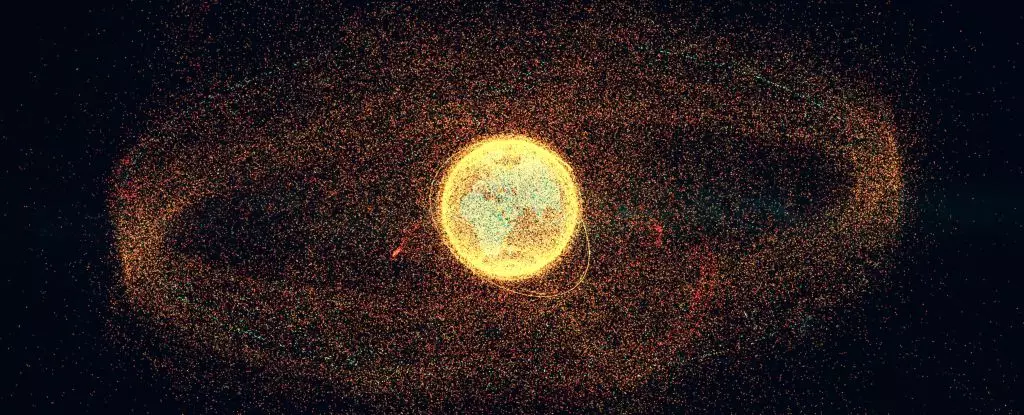In the quiet fabric of the cosmos, a significant crisis is brewing—a cacophony of abandoned satellites, rocket remnants, and stray fragments, all swirling around our planet. The European Space Agency (ESA) has issued alarming warnings in its annual Space Environment Report, indicating that the accumulation of space debris is not just a future threat but a present reality. The escalating rate of satellite launches dwarfs the rate at which these objects are brought down, leading to a dire situation where the risk of catastrophic collisions is ever-increasing. This is not merely academic jargon; the threat of a Kessler cascade—an uncontrollable chain reaction of collisions—looms closer with each passing day.
The severity of the situation cannot be overstated. Right now, the total number of space debris is estimated to be around 54,000 objects larger than 10 centimeters. Even more worrying is the estimated 1.2 million pieces ranging from 1 to 10 centimeters and a staggering 130 million tiny fragments between 1 millimeter and 1 centimeter. These numbers highlight a critical point: the density of space debris poses an existential risk not only to functioning satellites but also to important scientific missions like those of the International Space Station and the Hubble Space Telescope. While the scientific community has begun to frame possible mitigation strategies, the path to a solution remains fraught with challenges.
The Kessler Syndrome: A Scientific Consensus
The catastrophic potential of space debris has garnered a consensus among scientists, forming a united front of concern regarding what’s termed the Kessler Syndrome. The heart of the issue lies in the relationship between orbital debris and the orbital environment. Fragmentation events occur without warning, leading to an exponential increase in debris density. Even in a scenario devoid of new launches, the existing debris will only multiply due to fragmentation events outpacing natural re-entry processes. This understanding necessitates urgent action far beyond reactive strategies; it calls for an active cleanup of Earth’s orbital environment.
While advancements have been made in monitoring space debris—with tracking programs currently keeping tabs on approximately 40,000 objects—the data starkly reveals that merely waiting out the problem is insufficient. Assuming the issue is managed through time alone is a troubling misconception. ESA’s projections show that certain orbits could become perilous and unusable if we wait too long.
Future of Satellite Management: Built-in Obsolescence
Within the space industry, there has been a conscientious move towards planned obsolescence for satellites. This evolving norm aims for decommissioned satellites and spent rocket stages to be intentionally directed toward flame-drenched re-entry into Earth’s atmosphere. However, this process is neither immediate nor foolproof. Although the 2025 Space Environment Report provides a bleak yet enlightening snapshot, it highlights that monitoring and eventual burning of outdated objects need to become a priority. The 2024 data reflects some positive trends—more controlled re-entries and a reduction in uncontrolled atmospheric returns.
The statistics reveal that about 90% of rocket bodies in low-Earth orbits are now compliant with the re-entry standards established before 2023, meaning they’re exiting their orbits responsibly. There’s a flicker of hope when we observe that more than half of these bodies are now following controlled de-orbit procedures. Yet even with these strides, the scientific community emphasizes that this alone cannot mitigate the larger issue.
Cleaning Up the Cosmic Mess: A Global Responsibility
Initiatives aimed at cleaning up space debris are not just hopeful concepts; they are urgent necessities. The transition from mitigation to active cleanup requires innovative technologies and a framework for global cooperation. Imagine a future where humanity collaborates on technologies designed to harvest and repurpose debris. While such advancements may seem like science fiction, they must become part of our long-term strategy for maintaining a healthy orbital ecosystem.
Governments, private enterprises, and international organizations must come together to address the pressing need for a sustainable approach to managing our space environment. This collaborative effort will not only protect existing satellites but also pave the way for future explorations in a safer, more reliable orbital landscape. Humanity needs to prioritize this shared responsibility, lest we forfeit our right to explore and utilize space in the years to come.
Without intentional action, the vastness of space might become an inhospitable environment, obstructing future endeavors and discoveries. The time for complacency has passed; it is now crucial for us to act decisively and collectively to secure the final frontier. The cosmos is not just the playground of a few; it belongs to all of humanity, and it is our duty to keep it clean and accessible for generations to come.

